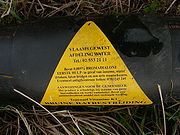
Vitamin K antagonist
Encyclopedia


Anticoagulant
An anticoagulant is a substance that prevents coagulation of blood. A group of pharmaceuticals called anticoagulants can be used in vivo as a medication for thrombotic disorders. Some anticoagulants are used in medical equipment, such as test tubes, blood transfusion bags, and renal dialysis...
s. They reduce blood clotting by inhibiting the recycling of vitamin K epoxide back to the active reduced form of vitamin K
Vitamin K
Vitamin K is a group of structurally similar, fat soluble vitamins that are needed for the posttranslational modification of certain proteins required for blood coagulation and in metabolic pathways in bone and other tissue. They are 2-methyl-1,4-naphthoquinone derivatives...
. The term Vitamin K antagonists is a misnomer
Misnomer
A misnomer is a term which suggests an interpretation that is known to be untrue. Such incorrect terms sometimes derive their names because of the form, action, or origin of the subject becoming named popularly or widely referenced—long before their true natures were known.- Sources of misnomers...
. These drugs do NOT antagonize the action of Vitamin K. See below for the mechanism of action.
They can cause birth defects (teratogens).
All VKAs can be neutralized in action by administration of vitamin K, although for the second generation "super warfarins" intended to kill warfarin resistant rodents, the time of vitamin K administration may need to be prolonged to months in order to combat the long residence time of the poison.
Coumarins (4-hydroxycoumarins)
CoumarinCoumarin
Coumarin is a fragrant chemical compound in the benzopyrone chemical class, found in many plants, notably in high concentration in the tonka bean , vanilla grass , sweet woodruff , mullein , sweet grass , cassia cinnamon and sweet clover...
s (more accurately 4-hydroxycoumarins
4-Hydroxycoumarins
4-Hydroxycoumarins are a class of vitamin K antagonist anticoagulant drug molecules derived from coumarin by adding a hydroxy group at the 4 position to obtain "4-hydroxycoumarin" , then adding a large aromatic substituent at the 3-position 4-Hydroxycoumarins are a class of vitamin K antagonist...
) are the most commonly used VKA (they are a subset of VKAs), and sometimes the terms are loosely used synonymously (though this also is not quite accurate).
In medicine, the most commonly used VKA is warfarin
Warfarin
Warfarin is an anticoagulant. It is most likely to be the drug popularly referred to as a "blood thinner," yet this is a misnomer, since it does not affect the thickness or viscosity of blood...
. The primary mechanism of warfarin is the inhibition of vitamin K epoxide reductase
Vitamin K epoxide reductase
Vitamin K epoxide reductase is an enzyme that reduces vitamin K after it has been oxidised in the carboxylation of glutamic acid. Its C1 subunit is the target of anticoagulant warfarin.- See also :* Oxidoreductase...
. Note that VKAs are not antagonists of Vitamin K. They are inhibitors of the enzymatic conversion of inactive Vitamin K epoxide to its reduced active form.
Certain VKAs are also used as rodenticides. Warfarin was initially used as a rodenticide, but made the transition to pharmaceutical. Eventually some rodents developed resistance to it. The "second generation" VKAs for dedicated use as rodenticides are sometimes called "super warfarins." These VKAs are enhanced to kill warfarin-resistant rodents. The enhancement to the molecule takes the form of a larger lipophilic group to enhance the fat solubility of the poison and greatly increase the time it acts within the animal's body.
For a more complete list of VKA's used is pharmaceuticals and rodenticides, see the main article above.
Other VKAs
Not all VKAs are coumarins. For example, fluindioneFluindione
Fluindione is a vitamin K antagonist....
is a VKA, but not a coumarin.
Another example is phenindione
Phenindione
Phenindione is an anticoagulant which functions as a Vitamin K antagonist.Hypersensitivity has been observed....
.
Many of the non-coumarin VKAs are 1,3-indandione
1,3-Indandione
1,3-indandione is an aromatic trans-fixed β-diketone, in standard conditions it is referred to in different sources as colourless or yellowish, green or yellow solid...
derivatives.

